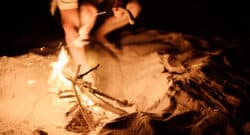Author: Shelly
Changing Traditions
By Ronald A. Barnett Jan 2004 According to the Oxford English Dictionary Tradition is a statement, belief, or practice handed down from generation to generation, generally by word of mouth. More vaguely, it is a long-established or generally accepted belief or method of procedure having almost the force of law. In today’s world of instant communication and rapid change formerly cherished beliefs and valued traditions are often thrown out in the deceptive name of progress. When does a particular tradition begin, how long does it last, and when does it end? Take for example the temazcal or traditional Mexican Sweat Bath. The use of the sweat lodge for relaxation and curative purposes is well-known. The Mexican type is the most highly developed. Graphic representations of Aztec sweat baths appear in the codices or painted hieroglyphic books and the actual physical remains have been preserved in many archaeological sites in Mexico. The Spanish chroniclers Sahagun and Duran also described them in some detail. Katuza, a personal friend of mine, is a resident of Ajijic and a fully qualified temazcalero. He has built and supervised many temazcals. There are two basic types: the curative and the spiritual. In the first the patient undergoes a set treatment, including a mudbath and a session in the jacuzzi. Tea and fruit are served. Then it is time for the steaming hot interior of the temazcal, followed by a cooling-off period. The basic purpose is to help to maintain good health as well as treat certain illnesses. The spiritual type involves rituals designed to enable participants to cast off everyday cares and release the inner spirit. In one temazcal the spiritual leader instructed us to make little skulls out of clay to remind ourselves of our own mortality. We then engaged in a Dervish-like dance intended to throw off all our inhibitions. Then each person was required to leave everything at the entrance to the temazcal and enter naked. Inside we sat side by side, male and female, around the central fire pit. The leader explained that we were all warriors of the sun and that we were about to face our true selves and reach for the outermost limits of our individual spiritual capacity. I can personally testify to the hypnotic effect of the spiritual temazcal. The Sweat Bath in Mexico can be traced back to classical Aztec times. For example, the Nahuatl phrase in cuauhtli in ocelotl (The eagle, the jaguar) refers back to the Aztec military orders, the Eagle and the Jaguar. This means warrior and symbolizes the self-sacrifice of the deity Nanahuatzin to ensure the continuation of the sun. Periodically, glowing hot rocks are shoveled into the fire pit. Each time the assistants raise the flap to the entrance everyone shouts OMETEO, which comes from the Aztec Ometeotl, the deity of Duality, a key concept in ancient Mesoamerican religion. Many more examples could be given of the preHispanic origins of the traditional Mexican Sweat Bath. Katuza and others continue to follow the old tradition, but the times are changing. In 1992 many Indian tribes celebrated the 500th year of survival of the indigenous peoples of the Americas. Sioux Indians, among others, visited Ajijic and over the ensuing years introduced some of their own rituals into the Mexican scene. More recently, entrepreneurs have begun to exploit the commercial value of the sweat bath by catering to rich clients who are willing to pay almost anything. Katuza reports that at one large spa clients are handed a list of items and services offered, along with fixed prices. Instead of following the instructions of a qualified guide, clients choose what they want for their particular session in the sweat bath. These changes are taking place in the construction and function of the traditional Mexican Sweat Bath. Cement and other materials are replacing traditional adobe brick. There are other changes as well. The problem is that the curative properties depend not only on the skill and knowledge of the operator but also on the proper materials, the method of construction, and the correct procedure. Much of this knowledge is therefore being lost through neglect and increasing commercialism. The traditional form is still around. How far these changes can go while still retaining the essential form and function of the traditional Mexican Sweat Bath only the future will tell. On the other hand many people today are searching for a return to some kind of traditional wisdom to counter the imbalance in their personal lives. The ancient Greeks had a saying: The half is better than the whole. So perhaps even a little of the old tradition is better than nothing.

